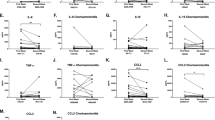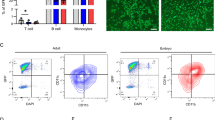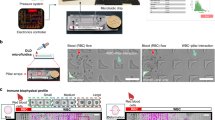Abstract
Background
Preterm infants are at high risk of infection and have distinct pathogen recognition responses. Suggested mechanisms include soluble mediators that enhance cellular levels of cAMP. The aim of this study was to assess the relationship between blood cAMP concentrations and TLR-mediated cytokine production in infants during the first month of life.
Methods
Cord and serial peripheral blood samples (days of life 1–28) were obtained from a cohort of very preterm (<30 weeks’ gestational age) and term human infants. Whole-blood concentrations of cAMP and FSL-1 and LPS in vitro stimulated cytokine concentrations were measured by ELISA and multiplex bead assay.
Results
cAMP concentrations were higher in cord than in peripheral blood, higher in cord blood of female preterm infants, and lower at Days 1 and 7 in infants exposed to chorioamnionitis, even after adjusting for leukocyte counts. TLR2 and TLR4-mediated TNF-α, IL-1β, IL-6, IL-12p70, and IL-10 production in vitro increased over the first month of life in preterm infants and were positively correlated with leukocyte-adjusted cAMP levels and reduced by exposure to chorioamnionitis.
Conclusions
The ontogeny of blood cAMP concentrations and associations with chorioamnionitis and TLR-mediated production of cytokines suggest that this secondary messenger helps shape distinct neonatal pathogen responses in early life.
Similar content being viewed by others
Log in or create a free account to read this content
Gain free access to this article, as well as selected content from this journal and more on nature.com
or
References
Stoll, B. J. et al. Neonatal outcomes of extremely preterm infants from the NICHD Neonatal Research Network. Pediatrics 126, 443–456 (2010).
Levy, O. Innate immunity of the newborn: basic mechanisms and clinical correlates. Nat. Rev. Immunol. 7, 379–390 (2007).
Strunk, T. et al. Infection-induced inflammation and cerebral injury in preterm infants. Lancet Infect. Dis. 14, 751–762 (2014).
Hibbert, J. E., Currie, A. & Strunk, T. Sepsis-induced immunosuppression in neonates. Front. Pediatr. 6, 357 (2018).
Scheid, A. et al. Adjuvant effect of Bacille Calmette-Guerin on hepatitis B vaccine immunogenicity in the preterm and term newborn. Front. Immunol. 9, 29 (2018).
Philbin, V. J. et al. Imidazoquinoline Toll-like receptor 8 agonists activate human newborn monocytes and dendritic cells through adenosine-refractory and caspase-1-dependent pathways. J. Allergy Clin. Immunol. 130, 195.e9–204.e9 (2012).
van Haren, S. D. et al. Age-specific adjuvant synergy: dual TLR7/8 and mincle activation of human newborn dendritic cells enables Th1 polarization. J. Immunol. 197, 4413–4424 (2016).
Belderbos, M. E. et al. Plasma-mediated immune suppression: a neonatal perspective. Pediatr. Allergy Immunol. 24, 102–113 (2013).
Levy, O. et al. The adenosine system selectively inhibits TLR-mediated TNF-alpha production in the human newborn. J. Immunol. 177, 1956–1966 (2006).
Pettengill, M. et al. Soluble ecto-5’-nucleotidase (5’NT), alkaline phosphatase, and adenosine deaminase (ADA1) activities in neonatal blood favor elevated extracellular adenosine. J. Biol. Chem. 288, 27315–27326 (2013).
Kamenetsky, M. et al. Molecular details of cAMP generation in mammalian cells: a tale of two systems. J. Mol. Biol. 362, 623–639 (2006).
Sunahara, R. K. & Taussig, R. Isoforms of mammalian adenylyl cyclase: multiplicities of signaling. Mol. Interv. 2, 168–184 (2002).
Serezani, C. H. et al. Cyclic AMP: master regulator of innate immune cell function. Am. J. Respir. Cell Mol. Biol. 39, 127–132 (2008).
Dowling, D. J. & Levy, O. Ontogeny of early life immunity. Trends Immunol. 35, 299–310 (2014).
Platzer, C. et al. Cyclic adenosine monophosphate-responsive elements are involved in the transcriptional activation of the human IL-10 gene in monocytic cells. Eur. J. Immunol. 29, 3098–3104 (1999).
de Jong, E. et al. The phenotype and function of preterm infant monocytes: implications for susceptibility to infection. J. Leukoc. Biol. 102, 645–656 (2017).
Dong, Y. & Speer, C. P. Late-onset neonatal sepsis: recent developments. Arch. Dis. Child. Fetal Neonatal Ed. 100, F257–F263 (2015).
Redline, R. W. et al. Amniotic infection syndrome: nosology and reproducibility of placental reaction patterns. Pediatr. Dev. Pathol. 6, 435–448 (2003).
Strunk, T. et al. Histologic chorioamnionitis is associated with reduced risk of late-onset sepsis in preterm infants. Pediatrics 129, e134–e141 (2012).
de Jager, W. et al. Simultaneous detection of 15 human cytokines in a single sample of stimulated peripheral blood mononuclear cells. Clin. Diagn. Lab. Immunol. 10, 133–139 (2003).
Faucher, J. L. et al. “6 markers/5 colors” extended white blood cell differential by flow cytometry. Cytom. A 71, 934–944 (2007).
Schmidt, B. et al. Long-term effects of caffeine therapy for apnea of prematurity. New Engl. J. Med. 357, 1893–1902 (2007).
Hofer, A. M. & Lefkimmiatis, K. Extracellular calcium and cAMP: second messengers as “third messengers. Physiology (Bethesda) 22, 320–327 (2007).
Kemp, M. W. Preterm birth, intrauterine infection, and fetal inflammation. Front. Immunol. 5, 574 (2014).
Fish, E. N. The X-files in immunity: sex-based differences predispose immune responses. Nat. Rev. Immunol. 8, 737–744 (2008).
Klein, S. L., Marriott, I. & Fish, E. N. Sex-based differences in immune function and responses to vaccination. Trans. R. Soc. Trop. Med. Hyg. 109, 9–15 (2015).
Vasarhelyi, B. & Tulassay, T. Endocrine factors determining immune polarization during perinatal transition. Klin. Padiatr. 229, 261–266 (2017).
O’Driscoll, D. N., Greene, C. M. & Molloy, E. J. Immune function? A missing link in the gender disparity in preterm neonatal outcomes. Expert Rev. Clin. Immunol. 13, 1061–1071 (2017).
Carter, B. M. & Holditch-Davis, D. Risk factors for necrotizing enterocolitis in preterm infants: how race, gender, and health status contribute. Adv. Neonatal Care 8, 285–290 (2008).
Wallace, M. E. et al. Racial/ethnic differences in preterm perinatal outcomes. Am. J. Obstet. Gynecol. 216, 306.e301–306.e312 (2017).
Wall, E. A. et al. Suppression of LPS-induced TNF-alpha production in macrophages by cAMP is mediated by PKA-AKAP95-p105. Sci. Signal. 2, ra28 (2009).
Chavez-Valdez, R. et al. Mechanisms of modulation of cytokine release by human cord blood monocytes exposed to high concentrations of caffeine. Pediatr. Res. 80, 101–109 (2016).
Strunk, T. et al. Responsiveness of human monocytes to the commensal bacterium Staphylococcus epidermidis develops late in gestation. Pediatr. Res. 72, 10–18 (2012).
Speer, E. M. et al. Pentoxifylline inhibits TLR- and inflammasome-mediated in vitro inflammatory cytokine production in human blood with greater efficacy and potency in newborns. Pediatr. Res. 81, 806–816 (2017).
Konrad, F. M. et al. Protective effects of pentoxifylline in pulmonary inflammation are adenosine receptor A2A dependent. FASEB J. 27, 3524–3535 (2013).
Bolat, A. et al. Blood parameters changes in cord blood of newborns of hypertensive mothers. Eur. J. Pediatr. 172, 1501–1509 (2013).
Acknowledgements
This project was supported by a National Health & Medical Research Council (NHMRC) of Australia project grant award (572548). S.S.S. was supported by a Max-Kade fellowship. D.B. is supported by an NHMRC Senior Research Fellowship (1046518). Research at the Murdoch Children’s Research Institute is supported by the Victorian Government’s Operational Infrastructure Program. Work in O.L.’s laboratory was supported by U.S. National Institutes of Health (NIH) National Institutes of Allergy and Infectious Diseases (NIAID) grants 1RO1AI00135-01, Human Immunology Project Consortium (HIPC) award 1U19AI118608-01A1 and U01AI12484-01, as well as Global Health (OPPGH5284) and Grand Challenges Explorations (OPP1035192) awards from the Bill & Melinda Gates Foundation. The Precision Vaccines Program is supported by an internal award from the Boston Children’s Hospital Department of Pediatrics.
Author information
Authors and Affiliations
Contributions
T.S., S.D.v.H., M.P., D.B., O.L., A.J.C. made substantial contributions to conception and design. T.S., S.D.v.H., J.H., M.P., A.J.C. made substantial contributions to data acquisition and analysis. All authors made contributions to interpretation of data and drafting/revising critically for important intellectual content. All authors approve the version to be published.
Corresponding author
Ethics declarations
Competing interests
Over the past 5 years, O.L.’s laboratory has received sponsored research support from MedImmune and Crucell (Johnson & Johnson) and reagent support from the Infectious Diseases Research Institute. The other authors declare no competing interests.
Additional information
Publisher’s note Springer Nature remains neutral with regard to jurisdictional claims in published maps and institutional affiliations.
Rights and permissions
About this article
Cite this article
Strunk, T., van Haren, S.D., Hibbert, J. et al. Cyclic AMP in human preterm infant blood is associated with increased TLR-mediated production of acute-phase and anti-inflammatory cytokines in vitro. Pediatr Res 88, 717–725 (2020). https://doi.org/10.1038/s41390-019-0586-2
Received:
Revised:
Accepted:
Published:
Issue date:
DOI: https://doi.org/10.1038/s41390-019-0586-2
This article is cited by
-
Immune profiling of age and adjuvant-specific activation of human blood mononuclear cells in vitro
Communications Biology (2024)



